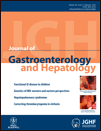Performance of double-balloon enteroscopy for the management of small bowel polyps in hamartomatous polyposis syndromes
Abstract
Background and Aim
Hamartomatous polyposis syndromes (HPS) are a group of rare inherited autosomal dominant disorders. Small bowel polyposis is one of the manifestations of HPS. Double-balloon enteroscopy (DBE) with polypectomy may obviate repeated small bowel surgeries for polyp intussusception, obstruction, or bleeding. The efficacy and safety of DBE-assisted polypectomy in HPS patients with clinically significant small bowel polyposis were evaluated.
Methods
All HPS patients who underwent DBE from January 2007 to April 2011 were identified using a prospectively maintained database. Data on patient demographics, pre-DBE radiological studies, polyp characteristics, procedural outcomes, and complications were abstracted.
Results
Twenty-two patients underwent a total of 34 DBE procedures. Pre-DBE imaging included computed tomography enterography (n = 15), computed tomography enteroclysis (n = 5), small bowel follow-through (n = 1), and magnetic resonance enterography (n = 1). Any small bowel polyp ≥ 1 cm in size on radiological imaging was referred for DBE-assisted polypectomy. Antegrade and retrograde DBE were successful in reaching and resecting targeted polyps in 90% (18/20) and 71.4% (10/14) of procedures, respectively. The overall success rate for DBE-assisted polypectomy was 82.3% (95% confidence interval: 66.5–91.6%). The median size of resected polyps was 2 cm (range 1–5 cm) and all were hamartomas. Minor adverse events occurred in four (11.8%) procedures, including abdominal pain (n = 2), immediate post-polypectomy bleeding (n = 1), and self-limited hematochezia (n = 1).
Conclusions
DBE-assisted polypectomy was successful in over 80% of HPS patients with an acceptable margin of safety. To the knowledge of the authors, this is one of the largest single-center studies to report on the performance and safety of DBE-assisted polypectomy in HPS patients.




